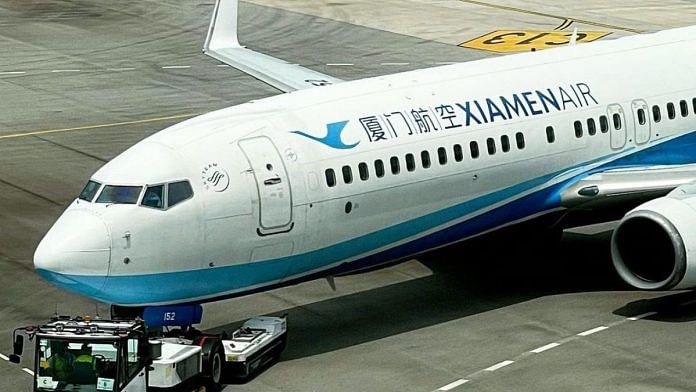With world leaders, like France’s Emmanuel Macron, Spain’s Pedro Sanchez and Singapore’s Lee Hsien Loong, travelling to Beijing in the past few weeks, people are under the impression that international travel to China has completely normalised. But international flights originating from and heading to the country haven’t witnessed the expected rebound after Beijing dropped the Covid-19 travel restrictions in November last year.
Though domestic travel in China has roared back with revenge, the dismal return of international flights reflects a deeper geopolitical tension.
Consultancy firm McKinsey had predicted that if the Chinese mainland’s recovery trajectory follows that of Hong Kong, then China would see four million air passengers monthly by April 2023. But that hasn’t turned out to be the case as both Chinese and international carriers struggle to reach the pre-pandemic levels of travel.
For seven days from 20 March, the number of international flights was just 19 per cent of the traffic experienced during the same period in 2019, according to data by Flight Master.
Take for example, the Chengdu to London Heathrow direct flight, which was supposed to resume by March; it still hasn’t taken off.
Also Read: After Saudi-Iran, China wants to displace America. But won’t be ‘policeman of the world’
No direct flights to US
The resumption of international flight activity will determine how Beijing reintegrates into the global economy after over two years of weak economic performance.
In April 2019, international traffic made up 12.4 per cent of Chinese airlines’ total traffic. Fast forward to April 2023, the international share of the traffic stands at 4.2 per cent of the overall traffic—though a marked recovery since Covid, it remains dismal at connecting international destinations.
Direct flights between the US and China remain suspended because of geopolitical tensions. Air China had applied to resume the direct flight to New York, which has remained mostly suspended for the last three years. But the US Department of Transportation is yet to approve the request.
In 2023, the top international destination for Chinese citizens is Thailand, for which Chinese and international airlines have added 256,000 additional seats in April. Thai tourism industry is heavily dependent on Chinese tourists, and the country has welcomed them back with open arms. It’s followed by South Korea, which got 244,000 seats, marking an increase of 117 per cent.
The increased flight activity to Thailand could also point towards Bangkok acting as a transit airport for many Chinese travellers who use the city as a point of connection to fly to Europe, the US and Canada.
The increased reliance on the Bangkok transit route to reach the US and European capitals suggests that politics, not traffic, is the reason global capitals haven’t allowed direct flights from the Chinese mainland to resume.
Currently, there is no direct flight connecting New Delhi with Beijing as the visa restrictions on travellers from both countries remain in place. Travellers must either fly via Kazakhstan, Singapore, Hong Kong or Vietnam.
Also Read: China’s new strategy for Taiwan-US meet–show Xi as peacemaker, not rile up domestic protesters
Domestic travel on the rise
China may be struggling to reconnect the international flight routes, but domestic travel has surpassed even the pre-pandemic levels of travel.
China’s top three airlines, China Southern, China Eastern and Air China, have reached almost pre-pandemic levels of travel on the domestic routes. Domestic flights have come roaring back, reaching up to 80 per cent capacity – and even higher on certain routes – of the pre-pandemic level.
Air China now has 43 per cent more seats on the domestic routes, China Southern has 25 per cent more capacity, and China Eastern is operating at 18 per cent over the capacity compared to April 2019.
As domestic flight activity began to rebound in late 2022 and early 2023, the airlines struggled to bring back the cabin crew. But that’s now changing. Chinese airlines are now trying to attract cabin crew with special offers, especially those who can speak foreign languages. Hainan Airlines is recruiting staff who can speak English, French and Italian for its planned resumption of flight connections. The Chinese airlines have now received a deluge of applications for cabin crew roles.
China’s Civil Aviation Administration has justified the slow recovery of international flights after failing to resume international flights by April.
“Practically, however, it usually takes time for airlines to organise staff, coordinate resources and organise ticket sales. Intercontinental long-distance routes, in particular, may take longer to be implemented,” said Liang Nan, director of the transport department of the Civil Aviation Administration of China.
Beijing has set an ambitious target of operating 10,580 inbound and outbound international flights by 28 Chinese and 88 international airlines by 28 October.
“Air China will also gradually resume routes including Beijing-Rome, Beijing-Osaka, Beijing-Ho Chi Minh City, Shanghai-Milan, Shanghai-Osaka, Chengdu-London Heathrow, Chengdu-Phuket, Chengdu-Seoul and Hangzhou-Phuket” reported China Daily.
But China’s ambitions to restart business as usual hinges on their ability to manage increasingly fraught relations with the US, Europe, and the rest of the world.
The author is a columnist and a freelance journalist. He was previously a China media journalist at the BBC World Service. He is currently a MOFA Taiwan Fellow based in Taipei and tweets @aadilbrar. Views are personal.
(Edited by Theres Sudeep)



